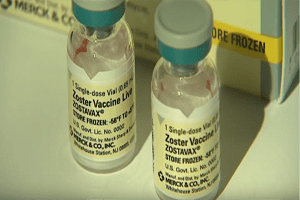
The Shingles Vaccine of Zostavax. The shingles (herpes zoster) vaccine, sold under the brand name Zostavax, is manufactured by Merck. The most common side effects associated with the shingles vaccine include redness, pain or tenderness, swelling, itchiness and headache. Since Zostavax uses a live vaccine, it should not be given to patients with a weakened […]

The Shingles Vaccine of Zostavax. The shingles (herpes zoster) vaccine, sold under the brand name Zostavax, is manufactured by Merck. The most common side effects associated with the shingles vaccine include redness, pain or tenderness, swelling, itchiness and headache. Since Zostavax uses a live vaccine, it should not be given to patients with a weakened immune system. Pregnant women and people who are allergic to the vaccine’s components, such as neomycin, should also not receive Zostavax, according to the U.S. Food and Drug Administration (FDA).
According to the FDA website, people under the age of 50 should also not receive the shingles vaccine because there is not enough evidence to determine its risks and benefits in these patients.
Shingles is caused by the same virus that leads to chicken pox; it affects an estimated 1 million people each year in the United States. People with shingles often develop a rash or blisters, typically affecting one side of the body. Shingles can affect anyone who has had chicken pox. The disease occurs when the virus, previously dormant in nerve cells, becomes re-activated and travels from the nerve cells to the skin. In addition to a rash, shingles can cause chills, upset stomach, shooting pain and long-lasting nerve damage in some patients.
According to an article published by Harvard Health Publications, the Advisory Committee on Immunization Practices recommended that all Americans ages 60 and older get the shingles vaccine even if they have already had shingles. Although rare, shingles can affect the same patient more than once. The articles notes that although this is the official recommendation, there may be other factors affecting an individual patient. The cost of the vaccine, insurance coverage, and any safety questions must be weighed against the benefits.
The clearest association with the development of shingles is age. As the body gets older, the immune system loses the ability to fight off the dormant virus.
Getting the shingles vaccine does not guarantee protection against shingles. Studies assessing the effectiveness of Zostavax found that it prevented shingles by about 50 percent. For people between the ages of 60 and 69, the effectiveness was highest at 64 percent. In older participants however, Zostavax was only effective for 41 percent of patients between the ages of 70 and 79. It was only 18 percent effective in patients 80 or older.
The shingles vaccine can reduce the risk of postherpetic neuralgia, nerve damage, by two-thirds, even if a patient develops shingles after being vaccinated.
Harvard Health Publications notes that a very small percentage of patients reported a chickenpox-like rash within a month of receiving the vaccine; this was reported in 0.3 percent (55 of 19,270 subjects). Some suspect that the vaccine was the cause, but this may also be due to “breakthrough infections” because the vaccine is only partially effective. A small Merck-sponsored study found that in two people who developed these rashes, the strain of shingles was the vaccine strain. However, testing was only done in a small number of cases. It is possible there were vaccine-associated rashes that were untested.
The personal injury attorneys at Parker Waichman LLP offer free, no-obligation case evaluations. For more information, fill out our online contact form or call 1-800-YOURLAWYER (1-800-968-7529).


